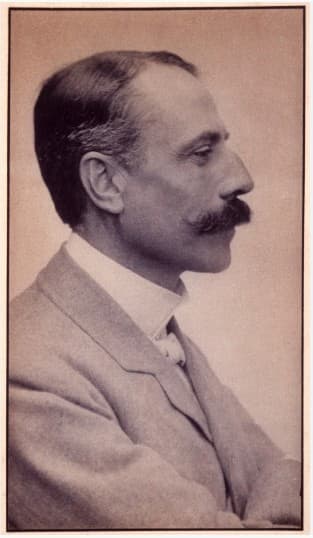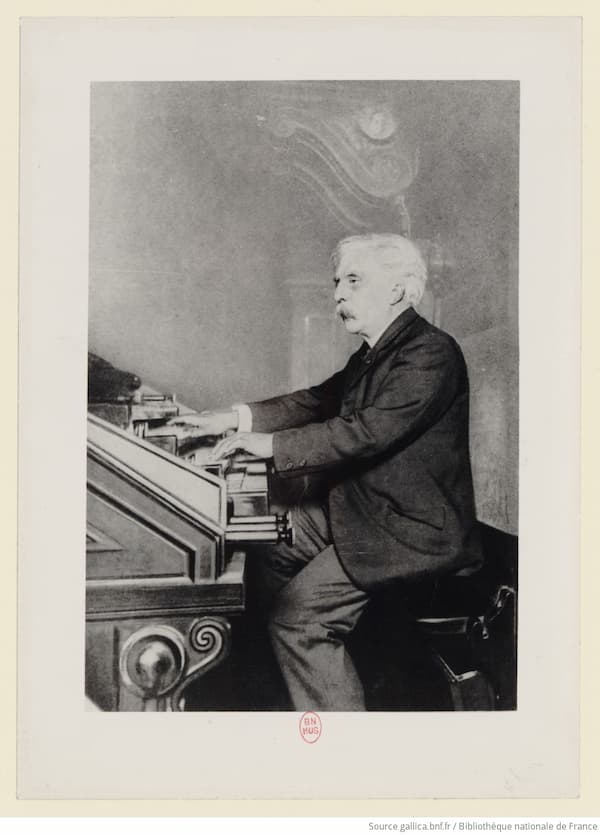Both Edward Elgar (1857–1934) and Gabriel Fauré (1845–1924) had only one successful string quartet. They were written some 8 years apart and both were in the key of E minor.

Edgar Thomas Holding: Edward Elgar, 1905
(London: National Portrait Gallery)

Gabriel Fauré at the organ of the church of the Madeleine (Gallica: ark:/12148/btv1b8417704k)
Elgar had tried writing string quartets since 1888 (destroyed), in 1878 (2 unfinished), and in 1907 (fragments only). It was only in the depth of despair of WWI and after an inspirational evening of chamber music in London in 1917 that he again addressed himself to the genre. In this return to an interest of his earlier years, Elgar the King of Ceremonial Music, could put aside that patriotic wrapping and look towards more intimate thoughts.
The use of the minor key for the quartet automatically pushes it toward ideas of regret and intimate revelation. There are philosophical ideas matched with a deep emotional expression. The restrained passion that stands behind the first theme for the opening movement is matched by the serenity of the second theme. We return, too, to the idea of a string quartet being an intelligent conversation between four equals, particularly in the recapitulation. The brief coda ends in E major.
Edward Elgar: String Quartet in E Minor, Op. 121 – I. Allegro moderato
The Andante second movement, now in C major, silences the first violin at the beginning of the work until it takes its entrance and doubles the second violin an octave higher. The music flows, reminding us that the war so busily fought on the mainland is unnecessary—consider peace.
In the final movement, an Allegro molto, Elgar expands his ideas in his journey of hope.
Two contemporaries couldn’t be more unlike than Elgar and Fauré. They met only once, in London, at the premiere of Elgar’s First Symphony in 1908. After Fauré’s death, Elgar wrote to a mutual acquaintance that he regretted the neglect of Fauré’s chamber music in England.
Fauré’s E minor string quartet, his final composition, was composed after he had completely lost his hearing. His last 15 years were spent with serious hearing disorders. Not only was he going deaf, but the pitches he could hear were distorted, so that high notes and low notes were only heard as out of tune.
The string quartet had been something his friends had been urging him to do for years. He’d been the dedicatee of Ravel’s String Quartet in 1903 but felt the genre was too difficult for him to attempt. When he started it, he felt the influence of composers such as Beethoven, who were so famous for their quartet, saying that the genre ‘…causes all those who are not Beethoven to be terrified of it’. He finished it 2 months before he died and never heard a performance of it, declining an offer for a private performance because of his hearing problems. The premiere took place on 12 June 1925 at the Salle du Conservatoire, organised by the Société nationale de musique, with Jacques Thibaud and Robert Krettly (violins), Maurice Vieux (viola), and André Hekking (cello).
Fauré started his work on the piece from the inside out, first completing the middle Andante movement and then matching the outer movements to its sober and meditative feeling.
The first and last movement are in sonata form. The middle movement does not use any traditional form. Except for the repeat of the opening theme in the middle of the movement, the music flows onward. Fauré’s expression of a spirit that is aethereal, mysterious, and opaque comes through the music, unique for its time. It’s music of half-lights and a momentary chill and a sublime statement of the indefinite.
Gabriel Fauré: String Quartet in E Minor, Op. 121 – II. Andante
Beyond these two string quartets, the Eusebius Quartet has included 4 other works by the two composers, arranged for string quartet. Elgar’s Carissima, composed in 1913 for small orchestra and only 85 measures long, has been transcribed for string quartet by Iain Farrington. It was intended for recording by HMV Records as Elgar explored the new technology.
Iain Farrington also arranged 3 of Fauré’s Piano Préludes, Op. 103, for string quartet. The expansion of the work into the string quartet gives us a better appreciation of Fauré’s harmonic simplicity and ability to create worlds of mystery and emotion.

Eusebius Quartet (photo by Anna Patarakina)
The London-based Eusebius Quartet was formed in 2016, taking its name from Robert Schumann’s ‘philosophical and dreamy Eusebius’. The Quartet’s first recording, Erich Korngold’s String Quartet and Quintet (SOMMCD 0642), was named ‘Recording of the Month’ by BBC Music Magazine in January 2022. Their performance is quiet and commanding, taking Elgar’s and Fauré’s individual measure and bringing forth deep and understanding performances.

Elgar and Fauré: String Quartets
Eusebius Quartet
SOMM Recordings (SOMMCD 0703)
Release date: 16 May 2025
For more of the best in classical music, sign up for our E-Newsletter
